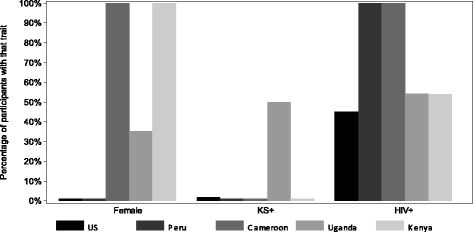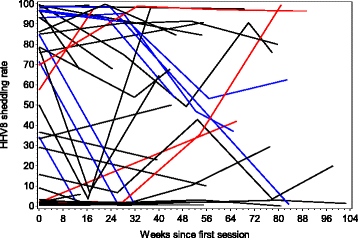Patterns of human herpesvirus-8 oral shedding among diverse cohorts of human herpesvirus-8 seropositive persons
- PMID: 26865856
- PMCID: PMC4748452
- DOI: 10.1186/s13027-016-0052-2
Patterns of human herpesvirus-8 oral shedding among diverse cohorts of human herpesvirus-8 seropositive persons
Abstract
Background: Human herpesvirus-8 (HHV-8), the etiologic agent of Kaposi sarcoma (KS), establishes lifelong latent infection with periodic lytic replication ("shedding") at mucosal sites, especially the oropharynx. Patterns of HHV-8 shedding are not well understood, and require elucidation to better predict risk of HHV-8 related malignancies in those infected. We sought to characterize patterns of HHV-8 oropharyngeal shedding among diverse cohorts that enrolled HHV-8 seropositive persons.
Methods: We quantified HHV-8 oral shedding using PCR among HHV-8 seropositive persons who collected at least 14 days of oral swabs in 22 studies on 3 continents. We excluded persons taking antivirals during sampling or any prior use of antiretrovirals in those who were HIV-infected.
Results: 248 participants were enrolled from the US, Peru, Cameroon, Uganda, and Kenya; 61 % were men, 58 % were HIV seropositive, and 16 % had KS. Overall, 3,123 of 10,557 samples (29.6 %) had HHV-8 detected. Quantity of virus shed was highly correlated with shedding rate, (ρ = 0.72, p < 0.0001). HHV-8 was detected in ≥1 sample in 55 % of participants with a median of 7 % of days in the US and Kenya, 0 % in Uganda and Peru, and 18 % in Cameroon. Median episode duration was three days, and episodes with high median quantity lasted longer (42 vs 3 days, p < 0.0001). In persons with multiple observations over time, 66 % of shedding rate variance was attributable to differences between individuals.
Conclusions: In HHV-8 infected individuals from diverse settings, oral mucosal shedding rate, quantity, and duration were correlated; individual shedding was highly variable. Studies are needed to determine factors accounting for between-person variation and the relationship of HHV-8 shedding to development of associated diseases.
Keywords: HIV infections; Herpesviridae infections; Herpesvirus 8, Human; Kaposi sarcoma-associated herpesvirus (KSHV); Sarcoma, Kaposi; Virus replication.
Figures






References
-
- Koelle DM, Huang ML, Chandran B, Vieira J, Piepkorn M, Corey L. Frequent detection of Kaposi's sarcoma-associated herpesvirus (human herpesvirus 8) DNA in saliva of human immunodeficiency virus-infected men: clinical and immunologic correlates. J Infect Dis. 1997;176(1):94–102. doi: 10.1086/514045. - DOI - PubMed
Grants and funding
LinkOut - more resources
Full Text Sources
Other Literature Sources

